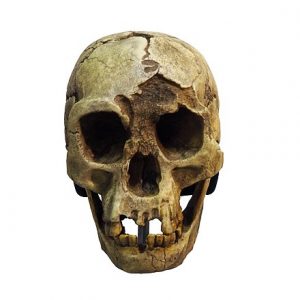Homo Floresiensis, The Hobbit.
Homo floresiensis (“Flores Man”; nicknamed “Hobbit”) is a species of small archaic human that inhabited the island of Flores, Indonesia, until the arrival of modern humans about 50,000 years ago.
 The remains of an individual who would have stood about 1.1 m (3 ft 7 in) in height were discovered in 2003 at Liang Bua on the island of Flores in Indonesia. Partial skeletons of at least nine individuals have been recovered, including one complete skull, referred to as “LB1”. These remains have been the subject of intense research to determine whether they were diseased modern humans or a separate species; a 2017 study concludes by phylogenetic analysis that H. floresiensis is an early species of Homo, a sister species of Homo habilis.[/caption]
The remains of an individual who would have stood about 1.1 m (3 ft 7 in) in height were discovered in 2003 at Liang Bua on the island of Flores in Indonesia. Partial skeletons of at least nine individuals have been recovered, including one complete skull, referred to as “LB1”. These remains have been the subject of intense research to determine whether they were diseased modern humans or a separate species; a 2017 study concludes by phylogenetic analysis that H. floresiensis is an early species of Homo, a sister species of Homo habilis.[/caption]
This hominin was at first considered remarkable for its survival until relatively recent times, initially thought to be only 12,000 years ago. However, more extensive stratigraphic and chronological work has pushed the dating of the most recent evidence of its existence back to 50,000 years ago. The Homo floresiensis skeletal material is now dated from 60,000 to 100,000 years ago; stone tools recovered alongside the skeletal remains were from archaeological horizons ranging from 50,000 to 190,000 years ago
Discovery
The first specimens were discovered on the Indonesian island of Flores on 2 September 2003 by a joint Australian-Indonesian team of archaeologists looking for evidence of the original human migration of modern humans from Asia to Australia. They instead recovered a nearly complete, small-statured skeleton, LB1, in the Liang Bua cave, and subsequent excavations in 2003 and 2004 recovered seven additional skeletons, initially dated from 38,000 to 13,000 years ago.

Liang Bua Cave, where the specimens were discovered
In 2004, a separate species Homo floresiensis was named and described by Peter Brown et al., with LB1 as the holotype. A tooth, LB2, was referred to the species. LB1 is a fairly complete skeleton, including a nearly complete skull, which belonged to a 30-year-old female, and has been nicknamed “Little Lady of Flores” or “Flo”. An arm bone provisionally assigned to H. floresiensis, specimen LB3, is about 74,000 years old. The specimens are not fossilized and have been described as having “the consistency of wet blotting paper”. Once exposed, the bones had to be left to dry before they could be dug up.
In 2009, additional finds were reported, increasing the minimum number of individuals represented by bones to fourteen. In 2015, teeth were referred to a fifteenth individual, LB15.
Stone implements of a size considered appropriate to these small humans are also widely present in the cave. The implements are at horizons initially dated to 95,000 to 13,000 years ago. Modern humans reached the region by around 50,000 years ago, by which time H. floresiensis is thought to have gone extinct. Comparisons of the stone artifacts with those made by modern humans in East Timor indicate many technological similarities.
